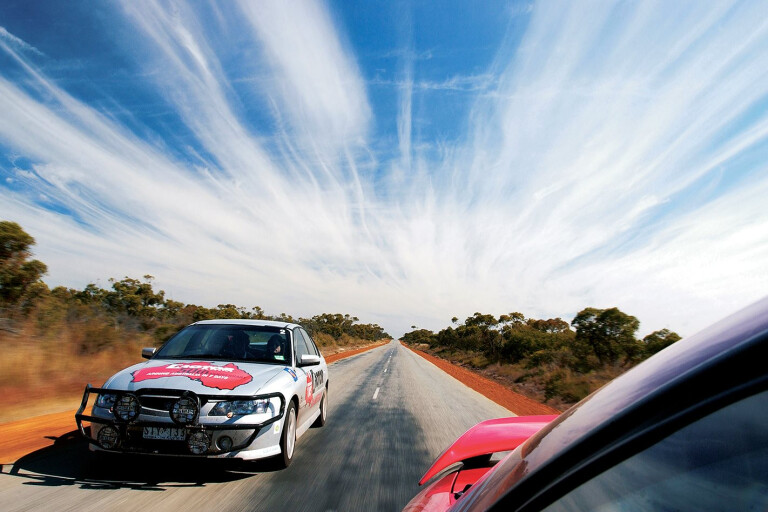
LEG 4: WA Border to Minilya Roadhouse
The difference between NT’s lack of restrictions and WA’s heavily-policed carriageways is… well, essentially, a speed limit. Equally open and safe, however, WA’s sheer scale turns a high-speed chortle into a chore.
This article was originally published in the June 2004 issue of MOTOR.
After a fill at Kununurra BP and a major hook left onto the Great Northern Highway, passing Warmun and Halls Creek’s 80km/h zone, we spotted, and were spotted by, an unmarked, white and beige two-seater helicopter. If anyone knows why, drop us a line.
Half-way between the NT/WA border and the coast placed us in Fitzroy Crossing. The grizzled local copper who called into its middle-of-nowhere BP as we stopped proclaimed proudly and loudly that he was booking people for minimal speeds over the limit, and was in a rush to get back to it.
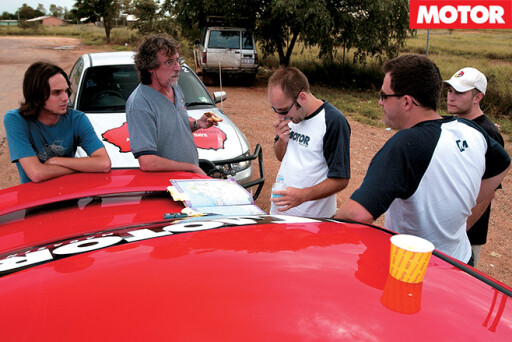 But worse news was to come from behind its counter: Tropical Cyclone Fay had flooded and closed the road around Pardoo, another 788km south. Big problem.
But worse news was to come from behind its counter: Tropical Cyclone Fay had flooded and closed the road around Pardoo, another 788km south. Big problem.
As if an excuse was needed, serial upper and downer Taylor J, in a moment of none-too-private despair and dire dummy spitting, proclaimed, “I’m gonna turn this car around and go home.” He began peeling off the red car’s ‘7 Days’ stickers, muttering about the cost of a flight from Darwin to Sydney.
After an hour’s deliberation, a call to Taylor M, and the passing of any number of profanities that shall remain undocumented, it was decided we would press on and cross any bridge, if and when.
At the Roebuck Roadhouse, 360km later, nearing midnight on day three, a ‘road closed’ sign arrested progress. That morning, TC Fay had passed between Pardoo and Wallal, about 300km south.
 With the option of driving on (illegal, and facing a $1000 fine if we needed rescuing), or spending a night in Broome, 34km away, with a sit-down meal, the world’s best shower and a decent sleep in a real bed was a no-brainer, and ours for the night. A ranger would declare the road open or closed at 8am.
With the option of driving on (illegal, and facing a $1000 fine if we needed rescuing), or spending a night in Broome, 34km away, with a sit-down meal, the world’s best shower and a decent sleep in a real bed was a no-brainer, and ours for the night. A ranger would declare the road open or closed at 8am.
Back to Roebuck at 7:30am local time, conflicting reports told of between 400mm and four metres (!) of water still on the road.
With visions of whale crossings in mind, should the Indian Ocean prove an obstacle, Cockburn had studiously organised a multi-car transporter for us – at $300 a car – but it proved unnecessary as, at 8:30am, the Great Northern Highway 1 reopened and we were mobile again.
 With our car clock still running on Sydney time, taking into account our one-hour stop at Fitzroy Crossing, our delay had been 14 hours. Fittingly, all those years before, Cyclone Hazel had slowed the progress of 1979’s effort in almost the same place.
With our car clock still running on Sydney time, taking into account our one-hour stop at Fitzroy Crossing, our delay had been 14 hours. Fittingly, all those years before, Cyclone Hazel had slowed the progress of 1979’s effort in almost the same place.
Surprisingly, all the water was just south of Roebuck: large water crossings, but still none more than ankle-deep. Around Pardoo BP, Fay had blown through, upped sticks and left little evidence.
Beyond Port Hedland, up the Northwest Coast Highway 1 through Karratha, the Minilya Roadhouse marked 8666km.
LEG 5: Minilya to Esperance
Overcoming misleading Highway 1 signs and our third accidental diversion, bypassing central Perth down the Old Coast Road 1, past Bunbury, and onto the South Western Freeway, our spirits lifted with daylight, good roads the turn due east at Wallpole.
 Beyond Albany on South Coast 1, and north east to Esperance, where we touched the Great Australian Bight, we clocked up 10,732km. And still the plains of the Nullarbor lay ahead.
Beyond Albany on South Coast 1, and north east to Esperance, where we touched the Great Australian Bight, we clocked up 10,732km. And still the plains of the Nullarbor lay ahead.
LEG 6: Esperance to Snowtown
The northbound 202km run to Norseman from Esperance gave us the trip’s most expensive refuel: 133.5 cents per litre! Did we mention our love for BP’s support?
The next leg of the Eyre Highway 1, the 146km of the ‘world’s longest straight’, cutting through the southern edge of the Nullarbor Plain, proved especially testing. A little over an hour, you say? Not at night! With kangaroos lined up at the roadside like bumpers on a pinball machine, keen roo spotter Taylor took the wheel and carved through, averaging 90-100km/h to constantly avoid the suicidal roos. Mentally, he was drained.
 Almost as much as the blonde at the Balladonia Roadhouse, the SA border was a welcome sight. And with daybreak, and the past four days giving us fresh perspective, Port Augusta, passed with ease. As did Snowtown. That was 12,757km in five days.
Almost as much as the blonde at the Balladonia Roadhouse, the SA border was a welcome sight. And with daybreak, and the past four days giving us fresh perspective, Port Augusta, passed with ease. As did Snowtown. That was 12,757km in five days.
LEG 7: Snowtown to Sydney
Adelaide’s arterial southbound route provided a welcome return run through civilisation, and on its M1, who should we spy but departing Ford boss Geoff Polites, out on a pre-launch drive with a fleet of new Ford Territory test cars.
The B1 run down to Mount Gambier on the Princes Highway 1, then into Victoria, was another stretch, but the run from there to Warrnambool and Geelong, thanks to nightfall, seemed painfully slow.
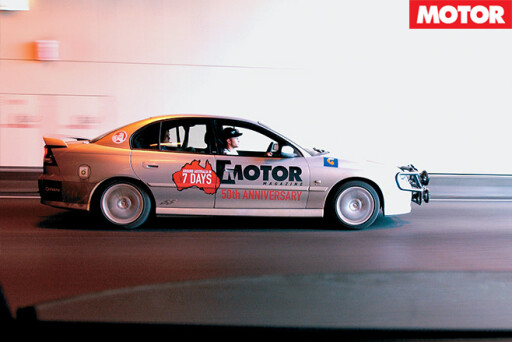 An attempt at enliven things by trying to kill those assembled in Car One – by blowing through a give-way sign he didn’t see – quickly relegated Wielecki to the rear’s sleeping seat.
An attempt at enliven things by trying to kill those assembled in Car One – by blowing through a give-way sign he didn’t see – quickly relegated Wielecki to the rear’s sleeping seat.
In Car One, Taylor J’s continual calculations had kept up our spirits. In spite of cyclone delays, we were still in with a real shot at the record. Even better, we never told Car Two it was possible!
After tasting unlimited speeds and some of the best roads in Australia, sitting safely on the multi-lane, divided, supremely flat and 100km/h-limited Princes Highway M1 approach to Melbourne was painfully and stupidly tedious. But not without amusement.
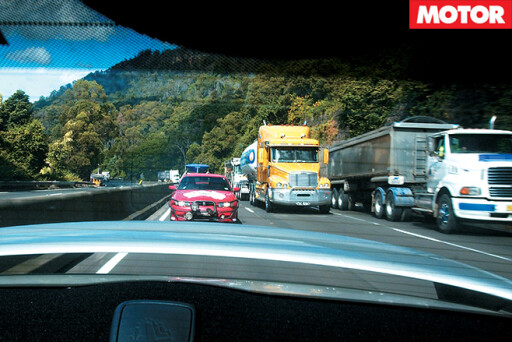 Attempting to spell out numberplates over the phone for the E-tag toll on Melbourne’s bypass, Taylor J was becoming increasingly agitated at each failed attempt. Better yet: the automated voice service at the other end seemed to be getting even angrier!
Attempting to spell out numberplates over the phone for the E-tag toll on Melbourne’s bypass, Taylor J was becoming increasingly agitated at each failed attempt. Better yet: the automated voice service at the other end seemed to be getting even angrier!
More scenic than the Hume Highway’s nine-hour Melbourne to Sydney dash, the Princes Highway M1 then A1 coast road, takes a little longer. But its 465km from Melbourne to the NSW border felt twice the distance. Around Morwell, a big red roo marked the fauna’s last serious attempt to take us out.
On the home stretch, the winding, rising and falling roads made sleep near-impossible. As signs for Batemans Bay, Ulladulla and Wollongong spelled increasing familiarity, with 537km to go, we phoned ahead to notify the welcoming party.
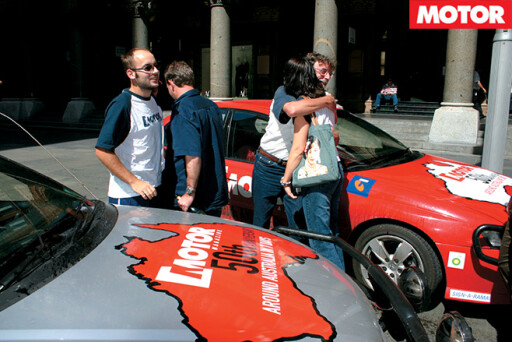 Stopping the official car clock at six days, 8 hours and 52 minutes, on Wednesday April 2, 12:52pm, we pulled onto the footpath at Martin Place.
Stopping the official car clock at six days, 8 hours and 52 minutes, on Wednesday April 2, 12:52pm, we pulled onto the footpath at Martin Place.
Amid popping champagne corks, and repeated questions of “are you guys raffling these cars?” from the gathering city lunchtime crowd, our mission was done. With delays, we’d driven around Australia in less than seven days. It felt like one long one.


COMMENTS